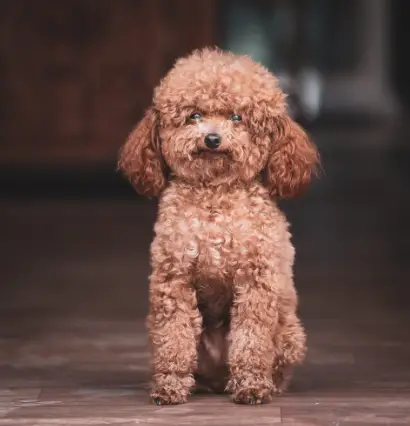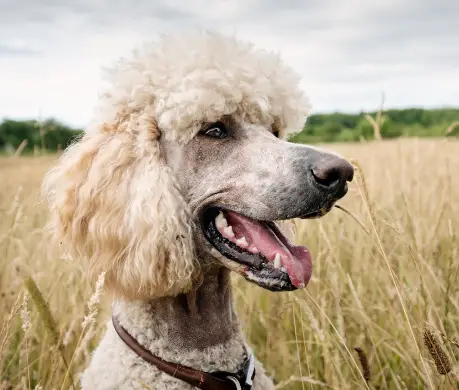Some people’s mental images of poodles include frou-frou show dogs prance around a ring. And it’s true that some breed members have performed well in these contests. But these sharp, active dogs are much more than that. The Poodle’s initial duty was to collect ducks from the water, and contemporary companion poodles still possess the intelligence and agility necessary for such activity. Here is a guide for those who are thinking about getting a poodle or who want to get along better with the one they already own.
How Much Food Should Be Given To A Standard Poodle?
The precise serving size varies considerably depending on the item. Calories differ significantly between moist and dry foods as well as between low- and high-quality foods. The quantity of food a Poodle should consume also varies according to the dog’s age, level of activity, personal metabolism, and state of health. Dogs tend to eat slightly more in the winter and slightly less in the summer, so even the weather can have an impact.
Puppies require more calories per pound than adult dogs do, at 40 to 55 calories per pound per day, as opposed to adult dogs, who require about 35 to 45 calories per pound per day. Due to their slower metabolisms and decreased movement, senior Poodles often need fewer calories, around 40 calories per pound. These figures are subject to 20% range adjustments.
Be sure to adhere to the recommended feeding recommendations if you are feeding your Poodle commercial food. These are typically rather accurate. Because these are based on both age and weight, know exactly how much your Poodle weighs rather than estimating it.
A general rule of thumb for serving size when feeding your Poodle homemade food is 1 ounce of food for every 1 pound of body weight, everyday. As you may expect, depending on the precise ingredients, this can vary quite a little. What your Poodle consumes within 15 minutes is typically a good amount for each meal, starting with the 1 to 1 rule.
- Wet vs Dry
Most Poodles would choose wet food if they could have their way. However, dry food is advised as it is more better for the teeth and gums. A diet consisting solely of wet canned food might result in messy feces, while dry kibble is generally easier on the stomach and intestines.
- Grain vs Grain-free
There was not much discussion on this topic until recently; if a dog had digestive or allergic problems on a diet that contained grains, they were moved to a recipe that was grain-free. This changed, though, when it was found that some dogs of breeds that were not predisposed to dilated cardiomyopathy also happened to be fed grain-free kibble and acquired that specific cardiac condition.
Many pet owners assumed right away that they needed to switch their dogs back to grains, but much more research needs to be done. In fact, the most recent report from the Tufts University Veterinary Medical Center indicates that being “grain-free” may not be the problem.
How Much Exercise A Standard Poodle Needs?
Puppies: Owners must plan their exercise hours carefully for dogs under 18 months old. Giving the puppy brief outdoor walks is a terrific method to help them burn off their excess energy.
However, severely exceeding the recommended amount of exercise for puppies might be harmful to their development.
Why? The bones are still building and expanding in standard Poodles at 18 months of age. Growth plates, which are soft regions containing rapidly dividing cells at the ends of all major bones, play a crucial role in enabling the bones to develop and lengthen as the Poodle pup matures from a puppy to an adult.
Adults: An adult Poodle between the ages of 2 (standard) and 7 (older) should exercise for 60 minutes every day. Do bear in mind that a dog’s need for a walk does not diminish based on how active the dog appears to be within the home. There may be days when your schedule makes it impossible or when the weather is so bad that you must provide alternatives, but they should be the exceptions.
With those 60 minutes divided into two 30 minute or three 20 minute sessions, the majority of Poodles perform better.
Senior: Do not fall into the trap of presuming an elderly dog does not require exercise. You should keep up your daily walks unless your senior Poodle has medical issues that prevent him from doing so. Some pet parents believe that an elderly Poodle is perfectly satisfied to lounge around the house. Being outside in the fresh air and extending their legs might give another wise ho-hum step a little vigor. Seniors are frequently complacent because they’ve seen and done it all, and little may thrill them.
Regular gentle activity helps senior dogs maintain muscle mass, reduces joint discomfort that is prevalent in older dogs, and provides all the advantages that it does for a senior dog’s younger counterparts.
Senior Poodles frequently get osteoarthritis; nevertheless, mild movement frequently helps to reduce symptoms, so this is something you should discuss with the vet. You should keep an eye on the older dog to see how he handles duration, reducing or slowing down the pace as necessary.
What Are Common Health Problems A Standard Poodle Has?
- Hip dysplasia: A condition that causes the ball and socket of the hip joint to not fit together properly. This condition increases the risk of developing arthritis or degenerative joint disease.
- Problems with the eyes: Toy and tiny poodles are among the breeds that may be more susceptible to progressive retinal atrophy, a genetic condition that results in retinal degeneration and blindness.
- Epilepsy: Poodles are susceptible to inheriting idiopathic epilepsy, which is epilepsy without a known underlying cause.
- Addison’s disease: Poodles are among the breeds with a higher chance of developing Addison’s disease, a disorder in which a dog’s adrenal glands fail to produce enough cortisol and aldosterone.
- Legg-Calve-Perthes: This degenerative condition affects the head of the femur, the “ball” of the “ball-and-socket” hip joint, and is more prevalent in miniature and toy poodles.
- Patellar luxation: Dogs who suffer from patellar luxation, in which the kneecap dislocates, are affected. Your poodle may pick up one leg and appear to skip for a few feet before kicking a leg out to pop the knee back into place. These are symptoms to watch for.
- Bloat: Gastric dilatation-volvulus, popularly known as “bloat,” can occur in poodles (GDV). It’s a potentially fatal ailment that needs to be treated right away because even a few minutes might be crucial.
- Von Willebrand’s Disease (VWD): Dogs with this inherited disorder don’t have enough of a protein that helps blood clot.
- Sebaceous adenitis: Standard poodles are more likely to acquire this disorder, in which the immune system assaults the sebaceous glands and causes symptoms like hair loss, scales, brittle hair, and sores.
- Collapsing trachea: Consult your dog’s veterinarian if you notice that they commonly have a dry cough that gets worse with pressure—such as from a collar—when they’re stimulated, or after they’ve recently consumed food or liquids.
- Dental issues: Poodles are susceptible to periodontal disease, much like many other pets. A veterinarian might need to take X-rays to find this because it frequently affects the roots of their teeth.
Do Standard Poodles Make Good Family Pets?
The Standard Poodle is a smart, energetic dog. Additionally, they require a lot of family members’ time and consideration.
For instance, this breed is not appropriate for houses where the owners work long hours. They will quickly grow bored in this circumstance and may even turn violent or unhappy.
Instead, houses that are extremely active and have a strong interest in training are best suited for them. The Poodle’s household should be able to give their dog enough of physical and mental attention.
In general, calm, responsible kids get along well with standard poodles. Despite their natural gentleness, they are fairly tall, which makes them physically intimidating to little children.
Conclusion
The modern Poodle is a spoiled indoor dog, despite the fact that this breed was originally used as a “water dog” to assist hunters in retrieving animals that had fallen into bodies of water like marshes and ponds.
The Poodle requires a variety of care that will all work together to maintain outstanding health, foster learning, and reinforce positive behavioral traits. It is crucial to lay the groundwork for good care that will endure throughout the Poodle’s life.







